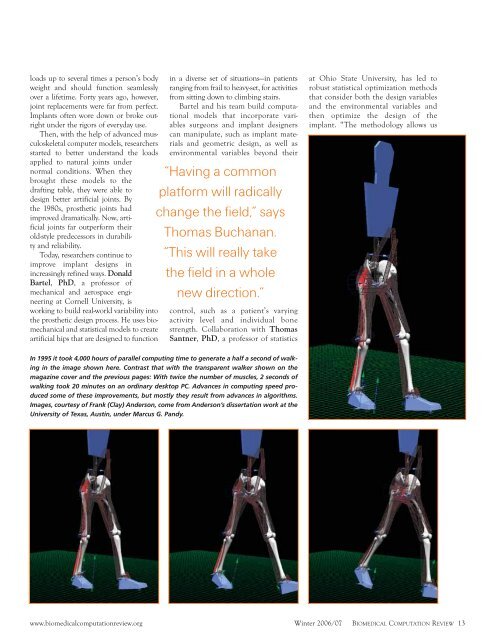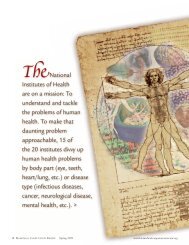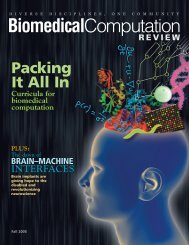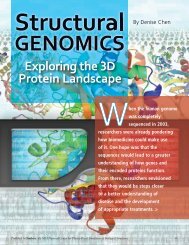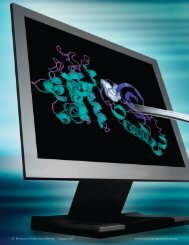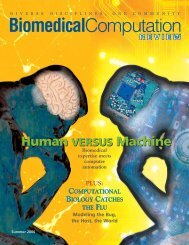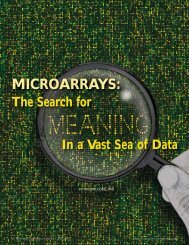Computational Biomechanics Computational Biomechanics
Computational Biomechanics Computational Biomechanics
Computational Biomechanics Computational Biomechanics
You also want an ePaper? Increase the reach of your titles
YUMPU automatically turns print PDFs into web optimized ePapers that Google loves.
loads up to several times a person’s body<br />
weight and should function seamlessly<br />
over a lifetime. Forty years ago, however,<br />
joint replacements were far from perfect.<br />
Implants often wore down or broke outright<br />
under the rigors of everyday use.<br />
Then, with the help of advanced musculoskeletal<br />
computer models, researchers<br />
started to better understand the loads<br />
applied to natural joints under<br />
normal conditions. When they<br />
brought these models to the<br />
drafting table, they were able to<br />
design better artificial joints. By<br />
the 1980s, prosthetic joints had<br />
improved dramatically. Now, artificial<br />
joints far outperform their<br />
old-style predecessors in durability<br />
and reliability.<br />
Today, researchers continue to<br />
improve implant designs in<br />
increasingly refined ways. Donald<br />
Bartel, PhD, a professor of<br />
mechanical and aerospace engineering<br />
at Cornell University, is<br />
working to build real-world variability into<br />
the prosthetic design process. He uses biomechanical<br />
and statistical models to create<br />
artificial hips that are designed to function<br />
in a diverse set of situations—in patients<br />
ranging from frail to heavy-set, for activities<br />
from sitting down to climbing stairs.<br />
Bartel and his team build computational<br />
models that incorporate variables<br />
surgeons and implant designers<br />
can manipulate, such as implant materials<br />
and geometric design, as well as<br />
environmental variables beyond their<br />
“Having a common<br />
platform will radically<br />
change the field,” says<br />
Thomas Buchanan.<br />
“This will really take<br />
the field in a whole<br />
new direction.”<br />
control, such as a patient’s varying<br />
activity level and individual bone<br />
strength. Collaboration with Thomas<br />
Santner, PhD, a professor of statistics<br />
at Ohio State University, has led to<br />
robust statistical optimization methods<br />
that consider both the design variables<br />
and the environmental variables and<br />
then optimize the design of the<br />
implant. “The methodology allows us<br />
In 1995 it took 4,000 hours of parallel computing time to generate a half a second of walking<br />
in the image shown here. Contrast that with the transparent walker shown on the<br />
magazine cover and the previous pages: With twice the number of muscles, 2 seconds of<br />
walking took 20 minutes on an ordinary desktop PC. Advances in computing speed produced<br />
some of these improvements, but mostly they result from advances in algorithms.<br />
Images, courtesy of Frank (Clay) Anderson, come from Anderson’s dissertation work at the<br />
University of Texas, Austin, under Marcus G. Pandy.<br />
www.biomedicalcomputationreview.org<br />
Winter 2006/07 BIOMEDICAL COMPUTATION REVIEW 13


